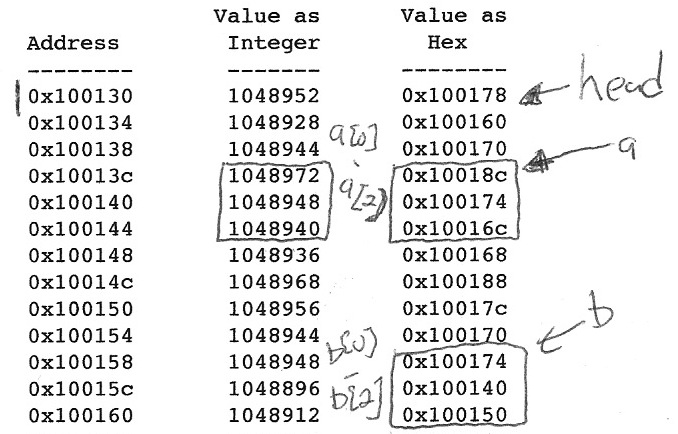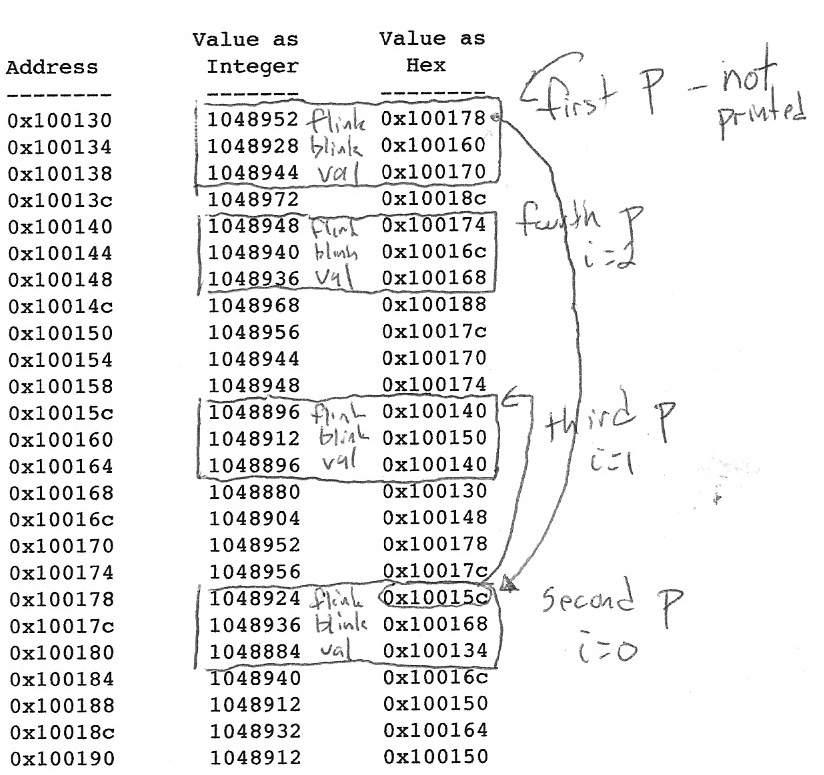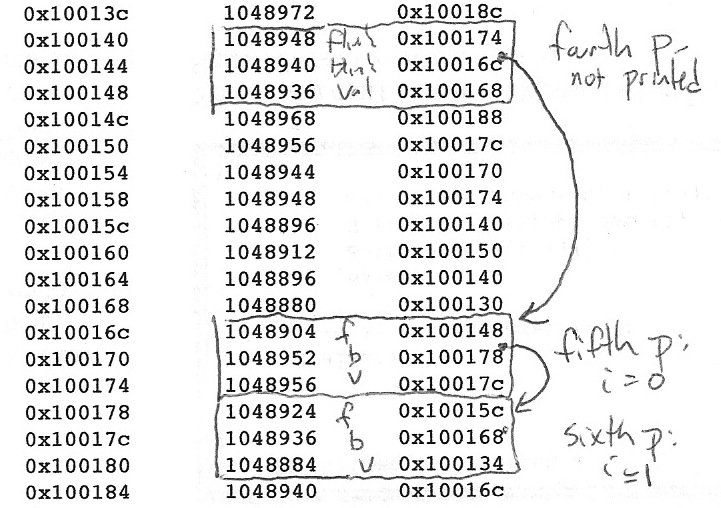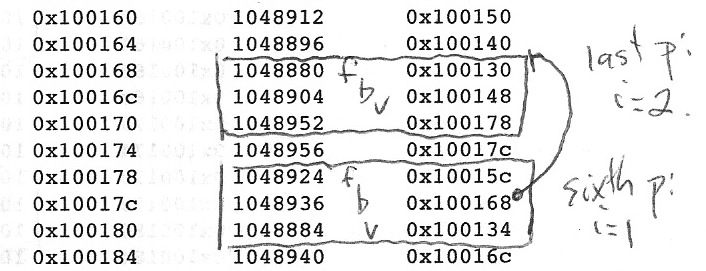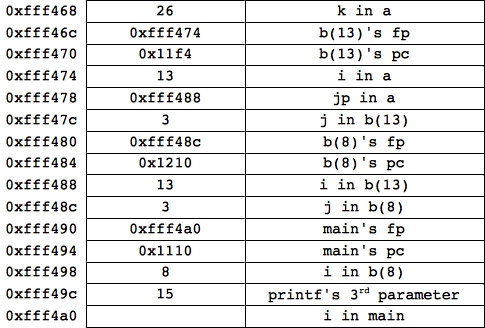CS360 Midterm Exam. March 14, 2013. James S. Plank
Answers and Grading
Question 1: 15 Points
Let's start as always by labeling some pointers in memory.
That gets us the three lines of output:
A[0] : 1048972
A[1] : 1048948
A[2] : 1048940
For the lines involving b, we need to look at what
b[0],
b[1] and
b[2] point to:
That allows us to print the next three sets of lines:
B[0] : 0x100174
B[0][0] : 1048956
B[0][1] : 1048924
B[0][2] : 1048936
B[1] : 0x100140
B[1][0] : 1048948
B[1][1] : 1048940
B[1][2] : 1048936
B[2] : 0x100150
B[2][0] : 1048956
B[2][1] : 1048944
B[2][2] : 1048948
The next loop is a little tricky. This is not a regular doubly-linked list. To
figure it out, start with p equaling head, and treat the 12 bytes as
a flink, blink and val as pictured below, lableled "first p."
We chase those flink pointers to get each successive p:
That gives us the next three lines of output:
0: p: 0x100178 p->val: 1048884
1: p: 0x10015c p->val: 1048896
2: p: 0x100140 p->val: 1048936
Then, starting with p = 0x100140, we chase blink pointers,
which are the second four bytes of each p. I do this in two drawings,
because the last p overlaps with the fifth p:
And that gives us the last three lines of output:
0: p: 0x10016c p->val: 1048956
1: p: 0x100178 p->val: 1048884
2: p: 0x100168 p->val: 1048952
Grading
- The A lines: 3 points
- The B[0] lines: 3 points
- The B[1] and B[2] lines: 4 points
- The first set of p lines: 3 points
- The second set of p lines: 2 points
Question 2
This is straight from the lecture notes (q2.c):
#include <stdio.h>
#include <stdlib.h>
#include <string.h>
#include "fields.h"
main()
{
char *l, *p;
IS is;
l = NULL;
p = NULL;
is = new_inputstruct(NULL);
while (get_line(is) >= 0) {
if (p != NULL) free(p);
p = l;
l = strdup(is->text1);
}
if (p != NULL) printf("%s", p);
exit(0);
}
|
There are of course other ways to do this.
Grading
10 points -- grading programs is more objective, so I handle each exam on a case
by case basis.
Question 3
For the answer, go ahead and see the scanned answer
when I did this by hand.
I decided that the exam was too long, so you didn't have to do part D.
Grading: 4 points per part.
Question 4
Let's build this up. The fp and sp start at 0xfff4a0. main()
will call push #4 to allocate i, and then it pushes 15 on the stack, as
printf()'s third argument. Then it pushes 8 on the stack for the b(8)
call, and it calls jsr b. This will push 0x1110 -- four bytes
after the pc, and the fp -- 0xfff4a0 onto the stack. So, when b(8)
starts to run, the stack looks like:
Now, we're in b(8). It decrements the stack pointer 4 bytes to allocate j
and sets j to three. Since the if statement is false, it recursively calls b
on 8+5 = 13. That part of the stack is:
Now, we're in b(13). Again, it allocates j and sets it to three. Since i
is indeed greater than 10, it now pushes &i and i onto the stack, and
calls jsr a:
Finally, we're in a(). It allocates k, and calculates i + *jp.
Since jp equals 0xfff474, *jp equals 13, so k is set to 26.
27 is put into r0, and we return with the entire stack looking as follows:
Grading
- Did you start with main() in the right place: 1 point
- Did you have a stack frame for main: 1 point
- Did you have a stack frame for b(8): 1 point
- Did you have a stack frame for b(13): 1 point
- Did you have a stack frame for a(): 1 point
- Are your return pc's correct: 1 point
- Are your return fp's correct: 1 point
- i in main: 1 point
- Printf's third parameter: 1 point
- B(8)'s parameter: 1 point
- B(13)'s parameter: 1 point
- i in both b calls: 1 point
- jp in a: 1 point
- i in a: 1 point
- k in a: 1 point
Question 5
You didn't have to do question 5, but here's the answer. It seems
sad to waste a perfectly good exam question, but there you have it.
